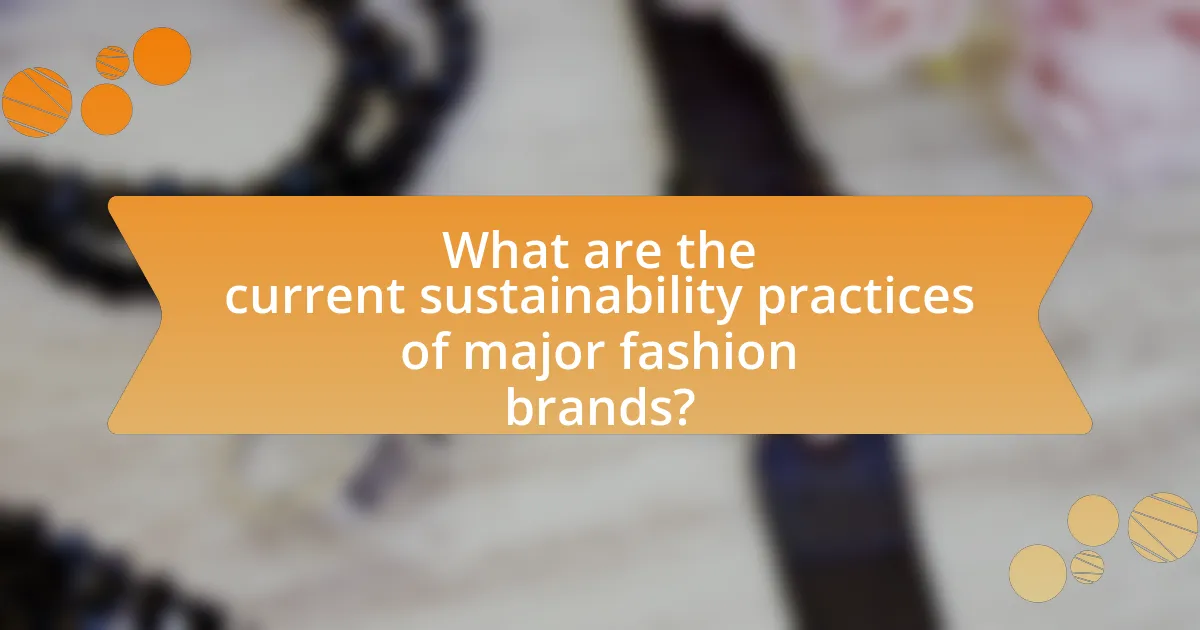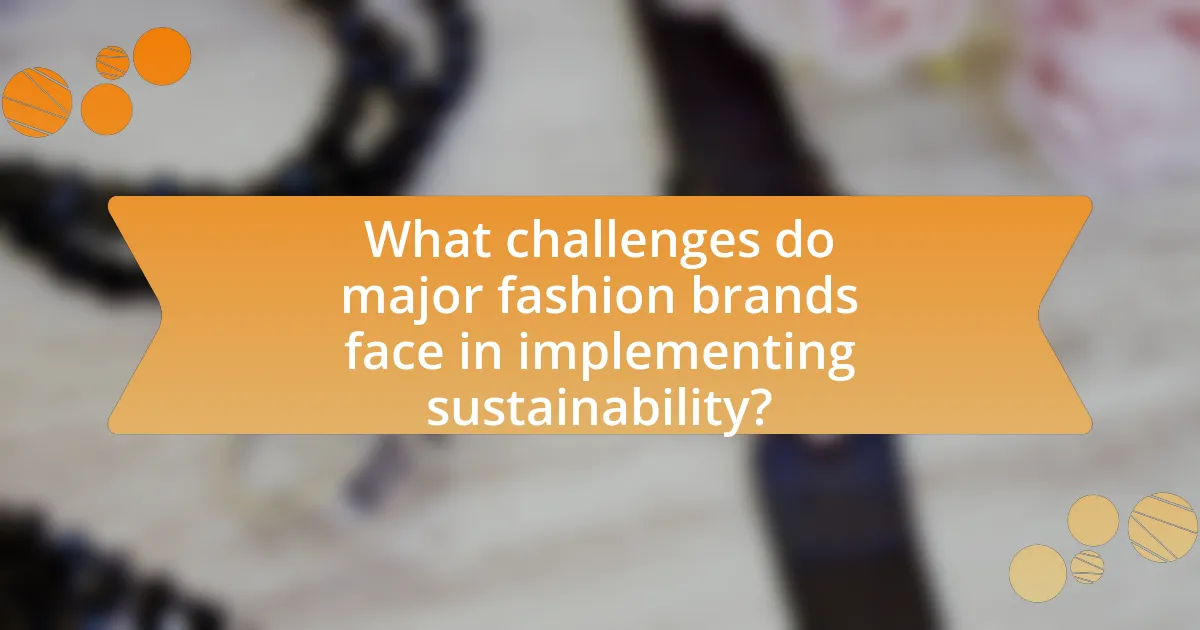The article analyzes the sustainability practices of major fashion brands, highlighting their commitment to eco-friendly materials, circular fashion initiatives, and supply chain transparency. It discusses how brands like H&M, Zara, and Patagonia define sustainability, the principles guiding their practices, and the common initiatives they adopt. The article also addresses the challenges brands face in implementing sustainable practices, including economic barriers and consumer demands, while emphasizing the importance of transparency and ethical labor practices. Additionally, it provides insights on how consumers can evaluate brand sustainability and the impact of their purchasing decisions on promoting sustainable fashion.

What are the current sustainability practices of major fashion brands?
Major fashion brands are increasingly adopting sustainability practices such as using eco-friendly materials, implementing circular fashion initiatives, and enhancing supply chain transparency. For instance, brands like H&M and Zara have committed to using 100% sustainable cotton and linen by 2025, while Nike has introduced a circular design approach that encourages recycling and reusing materials. Additionally, companies like Patagonia focus on fair labor practices and environmental activism, demonstrating a commitment to social responsibility. These practices are supported by industry reports indicating that sustainable fashion is projected to grow significantly, with a market value expected to reach $8.25 billion by 2023, reflecting consumer demand for ethical products.
How do major fashion brands define sustainability?
Major fashion brands define sustainability as the practice of creating products in a way that minimizes environmental impact and promotes social responsibility. This includes using eco-friendly materials, reducing waste through circular fashion initiatives, and ensuring fair labor practices throughout the supply chain. For instance, brands like Patagonia emphasize the use of recycled materials and transparency in sourcing, while H&M has committed to using 100% sustainable cotton by 2025. These definitions reflect a growing industry trend towards accountability and ethical practices, as evidenced by the Fashion Transparency Index, which highlights the increasing number of brands disclosing their sustainability efforts.
What key principles guide sustainability in the fashion industry?
Key principles guiding sustainability in the fashion industry include ethical sourcing, resource efficiency, waste reduction, and transparency. Ethical sourcing ensures that materials are obtained from suppliers who adhere to fair labor practices and environmental standards. Resource efficiency focuses on minimizing the use of water, energy, and raw materials throughout the production process. Waste reduction emphasizes the importance of recycling and upcycling materials to decrease landfill contributions. Transparency involves clear communication about sourcing, production processes, and the environmental impact of products, allowing consumers to make informed choices. These principles are supported by initiatives such as the Fashion Industry Charter for Climate Action, which aims to reduce greenhouse gas emissions in the industry by 30% by 2030.
How do these definitions vary among different brands?
Definitions of sustainability vary among different fashion brands based on their specific practices, goals, and marketing strategies. For instance, some brands prioritize environmental impact by focusing on eco-friendly materials and reducing carbon footprints, while others may emphasize social responsibility, such as fair labor practices and community engagement. A study by the Fashion Institute of Technology found that brands like Patagonia define sustainability through their commitment to environmental activism, whereas fast fashion brands often adopt a more superficial approach, highlighting recycling initiatives without substantial changes to their production processes. This divergence illustrates how brand identity and target audience influence the interpretation and implementation of sustainability concepts.
What are the common sustainability initiatives adopted by fashion brands?
Common sustainability initiatives adopted by fashion brands include the use of eco-friendly materials, ethical labor practices, and waste reduction strategies. Many brands are increasingly sourcing organic cotton, recycled polyester, and other sustainable fabrics to minimize environmental impact. Additionally, brands often implement fair trade practices to ensure workers receive fair wages and safe working conditions. Waste reduction initiatives, such as recycling programs and circular fashion models, aim to decrease textile waste and promote the reuse of materials. For instance, brands like H&M and Patagonia have launched programs to recycle old garments, demonstrating a commitment to sustainability in their operations.
Which brands are leading in sustainable materials usage?
Patagonia, Stella McCartney, and Nike are leading brands in sustainable materials usage. Patagonia utilizes recycled materials in over 70% of its products, significantly reducing environmental impact. Stella McCartney is known for its commitment to vegan materials and has pioneered the use of sustainable fabrics like organic cotton and recycled polyester. Nike has introduced its Move to Zero initiative, aiming for 100% renewable energy in its facilities and using recycled materials in over 50% of its products. These brands exemplify leadership in integrating sustainability into their material sourcing and production processes.
How do brands implement waste reduction strategies?
Brands implement waste reduction strategies by adopting practices such as circular design, material recycling, and supply chain optimization. Circular design involves creating products that can be easily disassembled and reused, which minimizes waste at the end of a product’s life cycle. For instance, brands like Patagonia have implemented take-back programs that encourage customers to return used items for recycling or resale, effectively reducing landfill contributions. Material recycling is another strategy, where brands utilize recycled materials in their products; for example, Adidas has produced shoes made from ocean plastic, significantly decreasing waste. Additionally, optimizing supply chains helps brands reduce excess inventory and minimize waste during production, as seen in companies like Zara, which employs just-in-time manufacturing to align production closely with demand. These strategies collectively contribute to a more sustainable approach in the fashion industry.
Why is transparency important in sustainability practices?
Transparency is crucial in sustainability practices because it fosters trust and accountability among stakeholders, including consumers, investors, and regulatory bodies. When fashion brands openly disclose their environmental and social impacts, it enables informed decision-making and encourages responsible consumption. For instance, a 2021 report by the Fashion Transparency Index found that only 23% of major fashion brands disclose their supply chain information, highlighting a significant gap in accountability. This lack of transparency can lead to consumer skepticism and damage brand reputation. Therefore, transparency not only enhances brand credibility but also drives industry-wide improvements in sustainability efforts.
How do brands communicate their sustainability efforts to consumers?
Brands communicate their sustainability efforts to consumers through transparent marketing, eco-labeling, and storytelling. For instance, many brands utilize social media platforms to share their sustainability initiatives, such as reducing carbon footprints or using recycled materials, which helps build consumer trust. According to a 2021 survey by Nielsen, 73% of global consumers are willing to change their consumption habits to reduce environmental impact, indicating that effective communication of sustainability can influence purchasing decisions. Additionally, certifications from recognized organizations, like Fair Trade or Global Organic Textile Standard, serve as proof of a brand’s commitment to sustainable practices, further enhancing credibility among consumers.
What role does third-party certification play in brand transparency?
Third-party certification enhances brand transparency by providing an independent verification of a brand’s claims regarding sustainability and ethical practices. This certification process involves rigorous assessments by accredited organizations that evaluate compliance with established standards, such as environmental impact, labor practices, and product safety. For instance, certifications like Fair Trade and Global Organic Textile Standard (GOTS) assure consumers that the products meet specific ethical and environmental criteria, thereby fostering trust. Research indicates that brands with third-party certifications experience increased consumer confidence, as 66% of global consumers are willing to pay more for sustainable brands, according to Nielsen’s Global Corporate Sustainability Report.

What challenges do major fashion brands face in implementing sustainability?
Major fashion brands face significant challenges in implementing sustainability, primarily due to supply chain complexities, high costs, and consumer demand for fast fashion. The intricate global supply chains often involve multiple stakeholders, making it difficult to ensure sustainable practices at every level. Additionally, transitioning to sustainable materials and processes typically incurs higher production costs, which can deter brands from making the necessary investments. Furthermore, consumer preferences for low-cost, rapidly produced clothing create pressure on brands to prioritize speed and affordability over sustainability. According to a 2021 McKinsey report, 66% of consumers are willing to pay more for sustainable brands, yet the majority still prioritize price and convenience, complicating the shift towards sustainable practices.
What are the economic barriers to sustainable practices?
Economic barriers to sustainable practices include high initial costs, lack of financial incentives, and market competition pressures. High initial costs arise from the investment required for sustainable materials and technologies, which can deter brands from adopting eco-friendly practices. Additionally, the absence of substantial financial incentives, such as subsidies or tax breaks for sustainable initiatives, limits the motivation for companies to transition. Market competition pressures further exacerbate the situation, as brands often prioritize short-term profits over long-term sustainability, leading to a reluctance to invest in sustainable practices that may not yield immediate financial returns.
How do production costs affect sustainability initiatives?
Production costs significantly influence sustainability initiatives by determining the feasibility and scope of environmentally friendly practices. When production costs are high, companies may prioritize cost-cutting measures over sustainable practices, leading to reduced investment in eco-friendly materials and processes. For instance, a study by the Ellen MacArthur Foundation highlights that brands often opt for cheaper, less sustainable materials to maintain profit margins, which undermines their sustainability goals. Conversely, when production costs are managed effectively, companies can allocate resources towards sustainable innovations, such as renewable energy sources and waste reduction strategies, thereby enhancing their overall sustainability efforts.
What impact do consumer demands have on sustainability efforts?
Consumer demands significantly influence sustainability efforts by driving brands to adopt eco-friendly practices. As consumers increasingly prioritize sustainable products, companies in the fashion industry respond by implementing environmentally responsible sourcing, production, and distribution methods. For instance, a 2021 survey by McKinsey & Company found that 67% of consumers consider sustainability when making a purchase, prompting brands to enhance transparency and reduce waste. This shift in consumer behavior compels fashion brands to innovate and invest in sustainable technologies, ultimately leading to a more sustainable industry.
How do brands address supply chain complexities?
Brands address supply chain complexities by implementing advanced technologies, enhancing collaboration, and adopting sustainable practices. For instance, many brands utilize data analytics and artificial intelligence to optimize inventory management and forecast demand accurately, which reduces waste and improves efficiency. Additionally, brands often engage in partnerships with suppliers to ensure transparency and traceability throughout the supply chain, fostering better communication and collaboration. According to a report by McKinsey & Company, companies that invest in digital supply chain technologies can achieve up to a 20% reduction in supply chain costs, demonstrating the effectiveness of these strategies in addressing complexities.
What challenges arise from sourcing sustainable materials?
Sourcing sustainable materials presents several challenges, including limited availability, higher costs, and supply chain complexities. Limited availability arises because sustainable materials, such as organic cotton or recycled polyester, are not produced in the same quantities as conventional materials, leading to competition among brands for these resources. Higher costs are often associated with sustainable materials due to more expensive farming practices or processing methods, which can impact a brand’s pricing strategy. Supply chain complexities occur as brands must navigate certifications, traceability, and ethical sourcing practices, which can complicate logistics and increase lead times. These challenges can hinder the widespread adoption of sustainable materials in the fashion industry.
How do brands ensure ethical labor practices in their supply chains?
Brands ensure ethical labor practices in their supply chains by implementing strict codes of conduct, conducting regular audits, and engaging in transparent reporting. These codes outline minimum labor standards, such as fair wages, safe working conditions, and the prohibition of child labor. Regular audits, often conducted by third-party organizations, assess compliance with these standards, ensuring that suppliers adhere to ethical practices. For instance, the Ethical Trading Initiative reports that brands that engage in regular monitoring see a significant reduction in labor violations. Additionally, many brands publish sustainability reports that detail their labor practices and progress, fostering accountability and transparency.
What are the criticisms faced by fashion brands regarding sustainability?
Fashion brands face significant criticisms regarding sustainability, primarily for their reliance on fast fashion practices that contribute to environmental degradation. Critics highlight issues such as excessive waste generation, with the fashion industry accounting for approximately 92 million tons of waste annually, according to the United Nations. Additionally, many brands are accused of greenwashing, where they promote misleading claims about their sustainability efforts without implementing substantial changes. Labor practices also come under scrutiny, as many brands source materials from countries with poor labor standards, undermining ethical sustainability. Furthermore, the use of non-biodegradable materials and harmful chemicals in production processes raises concerns about pollution and long-term ecological impact.
How do greenwashing claims affect brand credibility?
Greenwashing claims significantly undermine brand credibility by eroding consumer trust. When brands falsely promote their products as environmentally friendly, they risk backlash from consumers who value authenticity and transparency. A study by TerraChoice found that 95% of green products were found to be misleading in their environmental claims, leading to skepticism among consumers. This skepticism can result in decreased customer loyalty and negative brand perception, ultimately harming sales and long-term viability.
What are the consequences of failing to meet sustainability promises?
Failing to meet sustainability promises can lead to significant reputational damage for fashion brands, resulting in loss of consumer trust and loyalty. Research indicates that 66% of global consumers are willing to pay more for sustainable brands, meaning that unmet promises can directly impact sales and market share. Additionally, brands may face legal repercussions, including lawsuits or regulatory fines, as governments increasingly enforce sustainability standards. Financially, the cost of rectifying sustainability failures can be substantial, as brands may need to invest heavily in corrective measures to regain credibility. Overall, the consequences encompass reputational harm, financial loss, and potential legal challenges, underscoring the critical importance of adhering to sustainability commitments.

How can consumers evaluate the sustainability of fashion brands?
Consumers can evaluate the sustainability of fashion brands by examining their supply chain transparency, material sourcing, and environmental impact. Brands that disclose information about their production processes, such as the use of organic or recycled materials, demonstrate a commitment to sustainability. For instance, the Global Fashion Agenda’s 2021 report highlights that 66% of consumers are willing to pay more for sustainable brands, indicating a market shift towards eco-conscious purchasing. Additionally, certifications like Fair Trade or GOTS (Global Organic Textile Standard) provide verifiable proof of a brand’s sustainable practices, allowing consumers to make informed choices.
What criteria should consumers consider when assessing brand sustainability?
Consumers should consider environmental impact, social responsibility, and transparency when assessing brand sustainability. Environmental impact includes evaluating a brand’s carbon footprint, resource usage, and waste management practices. Social responsibility involves examining labor practices, community engagement, and ethical sourcing of materials. Transparency refers to how openly a brand communicates its sustainability efforts, including supply chain practices and certifications. For instance, brands that disclose their sustainability reports and third-party certifications, such as Fair Trade or Global Organic Textile Standard, demonstrate a commitment to accountability and ethical practices.
How can consumers identify genuine sustainable practices?
Consumers can identify genuine sustainable practices by looking for third-party certifications, transparency in supply chains, and clear environmental impact reports. Third-party certifications, such as Fair Trade, GOTS (Global Organic Textile Standard), and B Corp, provide verified evidence that brands adhere to specific sustainability standards. Transparency in supply chains allows consumers to trace the origins of materials and labor practices, ensuring ethical sourcing. Additionally, brands that publish detailed environmental impact reports demonstrate accountability and commitment to sustainability, providing metrics on carbon emissions, water usage, and waste management. These indicators collectively help consumers discern authentic sustainable practices from greenwashing.
What resources are available for consumers to research brand sustainability?
Consumers can research brand sustainability through various resources, including sustainability rating platforms, brand transparency reports, and third-party certifications. Websites like Good On You provide ratings based on ethical practices, while the Fashion Transparency Index evaluates brands on their disclosure of sustainability efforts. Additionally, certifications such as Fair Trade and Global Organic Textile Standard (GOTS) offer verified information on sustainable practices. These resources enable consumers to make informed choices by providing concrete data on brands’ environmental and social impacts.
What role do consumer choices play in promoting sustainability in fashion?
Consumer choices significantly influence sustainability in fashion by driving demand for eco-friendly products and practices. When consumers prioritize sustainable brands, they encourage companies to adopt environmentally responsible practices, such as using organic materials, reducing waste, and improving labor conditions. For instance, a 2021 survey by McKinsey & Company found that 67% of consumers consider sustainability when making a purchase, indicating a clear market preference for sustainable options. This consumer behavior compels brands to innovate and invest in sustainable practices to remain competitive, ultimately leading to a more sustainable fashion industry.
How can consumers influence brands to adopt better practices?
Consumers can influence brands to adopt better practices by leveraging their purchasing power and vocalizing their preferences for sustainable and ethical products. When consumers prioritize brands that demonstrate commitment to sustainability, companies are incentivized to improve their practices to meet market demand. For instance, a 2021 survey by McKinsey found that 67% of consumers consider sustainability when making a purchase, indicating a significant shift towards eco-conscious buying behavior. This consumer pressure can lead brands to adopt more sustainable materials, improve labor practices, and enhance transparency in their supply chains.
What are the benefits of supporting sustainable fashion brands?
Supporting sustainable fashion brands offers several benefits, including environmental protection, ethical labor practices, and economic support for local communities. Sustainable fashion brands typically use eco-friendly materials and processes, which significantly reduce waste and pollution; for instance, the fashion industry is responsible for 10% of global carbon emissions, and sustainable practices can help mitigate this impact. Additionally, these brands often prioritize fair labor conditions, ensuring workers receive fair wages and safe working environments, which contrasts with fast fashion’s exploitative practices. Furthermore, by choosing sustainable brands, consumers contribute to local economies, as many sustainable brands focus on small-scale production and local artisans, fostering community development and resilience.
What practical steps can consumers take to support sustainable fashion?
Consumers can support sustainable fashion by choosing to buy from brands that prioritize ethical production practices and environmentally friendly materials. This includes researching brands for their sustainability certifications, such as Fair Trade or Global Organic Textile Standard, which indicate adherence to ethical labor practices and reduced environmental impact. Additionally, consumers can opt for second-hand clothing, which reduces waste and the demand for new production, as evidenced by the fact that buying used clothing can save up to 80% of the resources needed for new garments. Furthermore, consumers can practice mindful consumption by purchasing fewer, higher-quality items that are designed to last, thereby minimizing their overall fashion footprint.
How can consumers make informed purchasing decisions?
Consumers can make informed purchasing decisions by researching the sustainability practices of fashion brands. This involves examining brands’ transparency regarding their supply chains, materials used, and environmental impact. For instance, a 2021 report by the Fashion Transparency Index found that only 40% of major fashion brands disclose their environmental policies, indicating a lack of transparency that consumers should consider. Additionally, consumers can utilize resources like the Good On You app, which rates brands based on their ethical practices, helping them choose more sustainable options. By prioritizing brands that demonstrate commitment to sustainability, consumers can contribute to more responsible fashion consumption.
What are some tips for reducing fashion waste in personal wardrobes?
To reduce fashion waste in personal wardrobes, individuals should focus on strategies such as buying less, choosing quality over quantity, and embracing second-hand shopping. Buying less minimizes the accumulation of unused clothing, while selecting high-quality items ensures longevity and reduces the need for frequent replacements. Additionally, purchasing from thrift stores or online resale platforms extends the lifecycle of garments and decreases demand for new production, which is a significant contributor to fashion waste. According to the Ellen MacArthur Foundation, the fashion industry is responsible for 92 million tons of waste annually, highlighting the importance of these practices in mitigating environmental impact.



